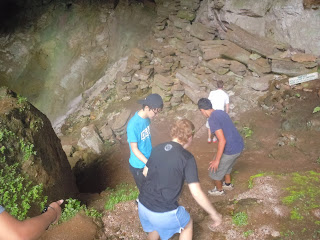This weekend, we had the opportunity to take the first big trip since going to Puerto Galera. Friday was Los Baños Day, so school was cancelled. We took this opportunity to head up north the towns of Banaue and Sagada. Banaue is known around the world for its rice terraces, which the Ifugao tribe began carving into the mountainside nearly 2000 years ago! On Thursday night, we took the night bus that left Manila at 10PM and arrived in Banaue at 8AM the next morning. Sleeping on the bus wasn’t easy, but it was awesome to be able to not waste daylight traveling. When we arrived in Banaue, we checked into Uyami’s Green View Lodge. The Ifugao are known for their wood carvings, and the lodge was a testament to this ancient tradition as its doors and handrails were carved with intricate pictures of the native Ifugao lifestyle. From the lodge, we were able to hire a van and a tour guide named Johnson to take us to Sagada for the day.
Sagada is only about 45 miles away from Banaue, but traveling through the winding mountain road took us almost 3 hours! The views from the car were absolutely beautiful though, so I don’t think anyone minded the drive. Once in Sagada, we ate at Masferre, named for the Eduardo Masferre, the father of Philippine photography. Masferre gained worldwide recognition in the 1980s for his work depicting the Ifugao village people who had been isolated from worldwide developments for thousands of years.
After lunch, we hired a couple of tour guides to take us through the Sumaging Cave. The tour guides first took us to Lumiang Cave, where we saw hundreds of “hanging coffins.” The Filipinos used to bury their dead in this manner, because they believed allowing your body to hang freely in space ensured that your soul would return to Mother Nature. In later years, Filipino’s started to stack the coffins, instead of hanging them off the side of cliffs.
 |
| Me making my way down a rock curtain waterfall. |
 |
| The group…happy to be safe at the bottom :) |
After the cave tour, we all slept pretty good that night! The next morning, we woke up and went on a 3 hour trek through the rice terraces in Banaue. Again, this was much more physically demanding than we anticipated—some parts required us to scramble up nearly vertical slopes without slipping (and yes, it was drizzling nearly the entire time!). I think I tripped/fell more often than everybody else combined in those two days, but I made it through!
Johnson was our tour guide again. His family owns and works about 50 levels of the rice terraces, so he was extremely knowledgeable about the whole process and the Ifugao traditions. According to Johnson, most of the rice grown on the terraces is for personal use. The breed of rice grown is the same rice that the area has been producing for thousands of years. It is organic and extremely hardy, so it grows without fertilizer and with little maintenance. The terraces are irrigated by an extensive system of channels that were designed by the original builders 2000 years ago.
 | ||
| Originally, the irrigation system was comprised of bamboo stalks much like this one, but these have been replaced by concrete channels in recent years. |
Among the Ifugao people, it is tradition to pass down the largest portion of the family rice terraces to the oldest child, a slightly smaller portion to the second child, and so on. The laws regarding such are so strict that issues of inheritance easily hold up in court.







